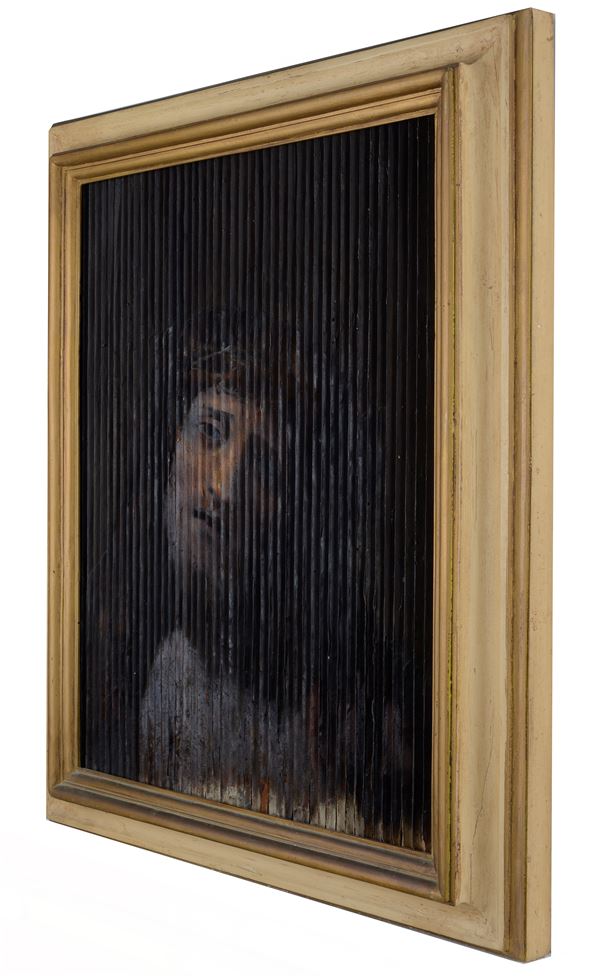Scuola Fiorentina, XVII sec.
Ecce Homo - Virgin of Sorrows
On the reverse: sealing wax stamp with cardinal's coat of arms. For a similar example, see the work attributed to Matteo Rosselli depicting Jesus and Saint Mary Magdalene preserved at the Museum of Sacred Art in San Gimignano (SI).
Interest in the perspective deformations of the figures , the subtle mechanisms of vision, the mysterious mental component of images, has its roots in classical Greco-Roman architecture and sculpture. However, it was with the formidable convergence, in the middle of the fifteenth century, between the renewed development of the mathematical sciences and the cult of perspective in drawing and painting, that the practice of anamorphosis became more and more widespread. Starting from a purely geometric interpretation of vision, the theme of form and its structure is being enriched with a complex range of distortions, alterations, decompositions which, through a precise point of view, can instantly regain their original orthodoxy and a perfect regularity of proportions and meaning. The proliferation of monstrous, enigmatic or ambiguous images, obtained with skilful artifice and capable of restoring specific figures of intact harmony through optical games, takes place between the sixteenth and early seventeenth centuries, marking in art the passage between the extreme manifestations of Mannerism and intensity imaginative of the early Baroque. The idea of altering an order of things from the inside without destroying it, the awareness that in the infinity of possible deviations there is a single original formal truth, are the basis of the anamorphic game. The scaled Tabula in which the painting proposed here consists represents a particular type of anamorphosis, for which it was necessary to use a mirror; it was particularly in vogue on the occasion of court feasts. It was built by fixing on a wooden support triangular prismatic wooden slats painted on both side faces; from a precise lateral angle, the right faces of the painted slats make up an image, the left faces, from the opposite angle, make up a completely different image, with a generally homogeneous thematic sense: a sovereign and his wife, L'Ecce Homo and Risen Christ, The Virgin and the announcing Angel. Frontally, the two images interpenetrate and dissolve into each other, generating the bizarre illusion of something magical, ghostly and impenetrable. The use of the mirror placed on the side to recompose the views in a frontal view of figures visible only alternatively, typical of anamorphosis, adds a strong symbolic value to this apparent game. Precise notations on the Tabula scalata are described in E. Danti in the Two Rules for the Practical Perspective by J. Barozzi da Vignola (1583) and in J.F. Niceron in the volume La perspective curieuse ou magie artificielle des effets merveilleux (1638). Already in Leonardo's Codex Atlanticus anamorphic drawings appear and it is through the encounter between Italian and Northern European culture - see as an example the famous "Ambassadors" of Hans Holbein the Younger (1533) and the "Self-portrait in one convex mirror ”by Parmigianino (1524) - that this interest, similar to the taste for the bizarre and the magic typical of the courts and aristocracy belonging to the Holy Roman Empire, spreads in Milan and Venice through emblematic figures such as Giuseppe Arcimboldo. Figures characterized by interests that go beyond art and practice mathematical and natural sciences, botany, biology, taxonomy. While in Baroque Rome the interest in anamorphosis emerges mainly in an architectural key, in Florence anamorphic practices spread above all in painting in a historical moment of particularly happy union between art and science, in the wake traced by artists such as Jacopo Ligozzi. The painting proposed here finds both a stylistic and thematic comparison with the scaled Tabula depicting "Jesus and Santa Maria Maddalena" attributed to Matteo Rosselli (Florence 1578 - 1650) coming from the Church of San Lorenzo a Montauto, near San Gimignano, and currently preserved at the Museum of Sacred Art of San Gimignano (SI).








